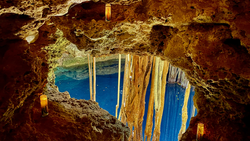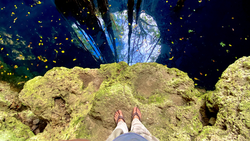There are hundreds (probably thousands) of cenotes within an easy drive of Macan ché. Below we'll report on either cenotes we have personally visited or those our guests have visited and enjoyed.
There are four different types of cenotes--those that are completely underground, those that are semi-underground, those that are at land level like a lake or pond, like the one at Dzibilchaltun, and those that are open wells, like the one in Chichén Itzá. Some of them are accessible for swimming and cave diving, but this is a sport that should ONLY be practiced with a professional guide.
Cuzama
This is a slice of "real" Yucatán. Until Hurricane Isidoro hit, the town of Cuzama was a working henequin hacienda. The great legacy of that time are the "truks," little horse-drawn carts once used to bring in the henequin for processing. The old hacienda contained three very lovely cenotes and now the truks are used to take visitors to the cenotes. It's about an 1-1/4 hour drive from Macan ché. We've had people leave as late as 2pm and still make a great trip of it (though they opted for only 2 cenotes due to the fading light).
This trip is fantastic and and always a big hit with our guests. The truk ride is 9 Km, so you might want to bring along some refreshments because you're heading out into the fields. Just sit back and enjoy the ride through the old henequin plantation. We'd suggest you go the last cenote first and then work your way back. The truk drivers will offer the option. If you go this way, you'll arrive at the end of the line and make your way to cenote Bolonchoojol.
Cenote Bolonchoojol "Nine Drops of Water" at Cuzama
This impressive cenote is the subject of MANY pictures used for publicity on cenotes in the Yucatán. (This is the cenote pictured at the beginning of this section.) The entrance is a hole in the ground with a strong wooden ladder. The hole looks narrow but once you get down, you will find yourself in a huge, well-lit cavern with the crystal clear blue toned water of the cenote. In the middle of the cenote the stalactites have formed what looks like a huge tree. Enjoy your swim here and don't forget those photographs!
Cenote Chansinic'che "Tree with Small Ants" at Cuzama
Back aboard the truk for a short ride to cenote, Chansinic'che. The access is pretty easy except for a very low area where the strong wooden ladder skirts the overhanging rock. It's an easy descent down the ladder for about 10 meters or 30 feet and you are in another transparent cenote for another refreshing swim.
Cenote Chelentun "Laying Down Rock" at Cuzama
If you go from the extent of the ride to Bolonchoojol and make your way back, you'll finally come to Chelentun. This cenote has the easiest access. The cement stairs and handrail make it easy to go down for a swim in the crystal clear water. The cave extends a long way back, but it is swimable. Make your way to the back of the cavern and look back at the natural arch and the beautiful pattern made by the 100-year-old concrete stairway. Then its back to the truk for a ride back to town and your adventure at Cuzama becomes a beautiful memory.
Useful Links:
Cenotes (pronounced seh-NO-tays) are a must for any visitor to the Peninsula. Here are some links to more information:
Cenotes on Wikipedia
The Secret Cenote Yokdzonot
Cenotes on Yucatan Today



